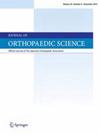Effect of bone density on the drill-hole diameter made by a cannulated drill bit in cancellous bone
IF 1.5
4区 医学
Q3 ORTHOPEDICS
引用次数: 0
Abstract
Background
When a pilot hole is made prior to a screw's insertion into bone, the same drill bit is used irrespective of the bone quality. However, osteoporotic bone is fragile and this may affect the hole diameter, which is of particular concern in cancellous bone. In this study, the relationship between bone density and drill-hole diameter was investigated assuming a pre-drilling process in screw-only osteosynthesis in the metaphysis and epiphysis.
Methods
Two types of drill bit (triple-flute [T] and quadruple-flute [Q]) with different shapes and diameters were prepared: type T bits with 3.5 mm and 4.4 mm diameters, and type Q bits with 3.5 mm and 4.2 mm diameters. Drilling was performed manually in simulated bones with four densities: 5, 10, 15, and 20 pounds per cubic foot. We measured the hole diameters with a coordinate measuring machine and analyzed the relationship between the drill-hole diameters and the densities of the simulated bones. We then compared the screw pull-out strength between the two 3.5-diameter drill bits.
Results
In all cases, the diameters of the drill holes were larger than those of the drill bits. The relationship between the drill-hole diameters and the bone densities was a negative linear correlation. Enlarging the hole diameter decreased the screw pull-out strength.
Conclusions
For cannulated drill bits of 3.5, 4.2 and 4.4 mm diameter, the diameter of the drill hole in cancellous bone obtained by the manual drilling technique tends to be larger in low-density (e.g., osteoporotic) compared to high-density (e.g., healthy) bone.
骨密度对插管钻头在松质骨中钻孔直径的影响。
背景:在螺钉插入骨之前打一个导孔,无论骨质量如何,都要使用相同的钻头。然而,骨质疏松的骨是脆弱的,这可能会影响孔的直径,这是特别关注的松质骨。在本研究中,假设在干骺端和骨骺仅螺钉内固定时进行预钻孔过程,研究了骨密度和钻孔直径之间的关系。方法制备两种不同形状和直径的钻头(三槽[T]和四槽[Q]):直径3.5 mm和4.4 mm的T型钻头和直径3.5 mm和4.2 mm的Q型钻头。在模拟骨骼中进行人工钻孔,密度为5、10、15和20磅/立方英尺。利用坐标测量机测量钻孔直径,分析钻孔直径与模拟骨密度的关系。然后,我们比较了两种3.5直径钻头的螺杆拔出强度。结果所有病例的钻孔直径均大于钻头直径。钻孔直径与骨密度呈负线性相关。增大孔径会降低螺杆的拉拔强度。结论对于直径为3.5、4.2和4.4 mm的空心钻头,手工钻孔技术在低密度(如骨质疏松)松质骨上获得的钻孔直径往往大于高密度(如健康)骨。
本文章由计算机程序翻译,如有差异,请以英文原文为准。
求助全文
约1分钟内获得全文
求助全文
来源期刊

Journal of Orthopaedic Science
医学-整形外科
CiteScore
3.00
自引率
0.00%
发文量
290
审稿时长
90 days
期刊介绍:
The Journal of Orthopaedic Science is the official peer-reviewed journal of the Japanese Orthopaedic Association. The journal publishes the latest researches and topical debates in all fields of clinical and experimental orthopaedics, including musculoskeletal medicine, sports medicine, locomotive syndrome, trauma, paediatrics, oncology and biomaterials, as well as basic researches.
 求助内容:
求助内容: 应助结果提醒方式:
应助结果提醒方式:


